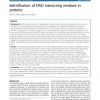100 search results - page 15 / 20 » Predicting protein folds with structural repeats using a cha... |
BMCBI
2010
13 years 7 months ago
2010
Background: Small molecular cofactors or ligands play a crucial role in the proper functioning of cells. Accurate annotation of their target proteins and binding sites is required...
JCB
2000
13 years 7 months ago
2000
We present a novel method for predicting the secondary structure of a protein from its amino acid sequence. Most existing methods predict each position in turn based on a local wi...
BMCBI
2008
13 years 7 months ago
2008
Background: Prediction of disulfide bridges from protein sequences is useful for characterizing structural and functional properties of proteins. Several methods based on differen...
ISMB
2000
13 years 9 months ago
2000
Knowing the number of residue contacts in a protein is crucial for deriving constraints useful in modeling protein folding, protein structure, and/or scoring remote homology searc...
IPPS
2006
IEEE
14 years 1 months ago
2006
IEEE
—Homology modeling requires an accurate alignment between a query sequence and its homologs with known three-dimensional (3D) information. Current structural modeling techniques ...

